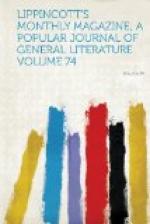[Illustration: “THE REPUTED GOLD-BEARING RIVER OR OUITUBAMBA ROLLED FROM ITS TUNNEL.”]
The Bolivians imagined an exploration of a little stream on the left bank, the Chuntapunco, which they thought might issue from a quinine-bearing region. They built a little raft, and departed with provisions for three or four days. They returned, in fact, after a week’s absence, with seven varieties of cinchona—the hirsuta, lanceolata, purpurea and ovata of Ruiz and Pavon, and three more of little value and unknown names.
During the absence of the cascarilleros a flat calm reigned in the ajoupa of Maniri. Garcia and the colonel, the day after their unproductive gold-hunt, betook themselves into the forest, ostensibly for game, but in reality to review their hopeful labors by the banks of the Ouitubamba. Aragon was detailed by Mr. Marcoy to accompany him in his botanical and entomological tours. On these excursions the acquaintance between the mozo and the senor was considerably developed. The youth had naturally a gay and confident disposition, and added not a little to the liveliness of the trips. Marcoy profited by their stricter connection to converse with him about the cultivation of the farm at Sausipata, making use of a venial deception to let him think that the plan of operations had been communicated by the governor himself. Aragon modestly replied that the plantation in question was only the first of a series of similar clearings contemplated by his uncle at various points in the valley. Arrangements made for this purpose with the governors of Ocongata and Asaroma, who were pledged with their support in return for heavy presents, would enable him soon to cultivate coffee and sugar and cocoa at once in a number of haciendas. The enterprise was a splendid one; and if God—Aragon pronounced the name without a particle of diffidence—deigned to bless it, the day was coming when the fortune of his uncle, solidly established, would make him the pride and the joy of the region.
It may as well be mentioned here that the subsequent career of the chest-nut-colored interpreter is not entirely unknown. In 1860, Mr. Clement Markham, collecting quinine-plants for the British government, came upon a splendid hacienda thirty miles from the village of Ayapata, in a valley of the Andes near the scene of this exploration. Here, on the sugar-cane estate named San Jose de Bellavista, he discovered “an intelligent and enterprising Peruvian” named Aragon, who appears to have been none other than our interpreter escaped from the chrysalis. His establishment was very large, and protected from the savages by two rivers, Aragon had made a mule-road of thirty miles to the village. He found the manufacture of spirits for the sugar-cane more profitable than digging for gold in the Ouitubamba or hunting for cascarillas along the Cconi. In 1860 he sent an expedition into the forest after wild cocoa-plants. An india-rubber manufactory had only failed for want of government assistance. He contemplated the establishment of a line of steamers on the neighboring rivers to carry off the commerce of his plantations. “Any scheme for developing the resources of the country is sure to receive his advocacy,” says Mr. Markham: “it would be well for Peru if she contained many such men.”




